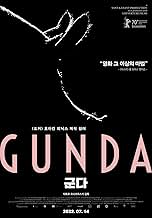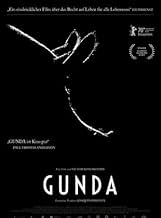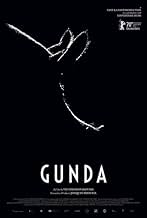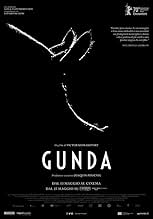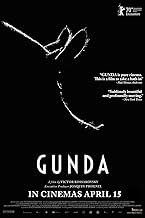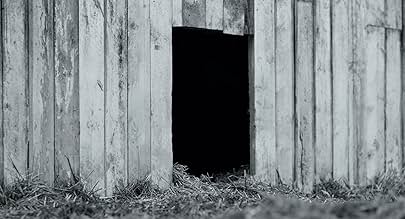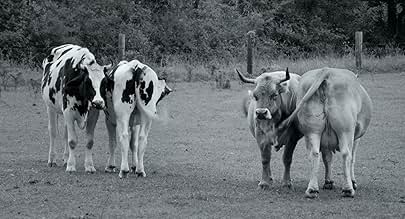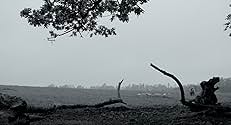IMDb रेटिंग
7.1/10
3.1 हज़ार
आपकी रेटिंग
अपनी भाषा में प्लॉट जोड़ेंDocumentary looks at the daily life of a pig and its farm animal companions: two cows and a one-legged chicken.Documentary looks at the daily life of a pig and its farm animal companions: two cows and a one-legged chicken.Documentary looks at the daily life of a pig and its farm animal companions: two cows and a one-legged chicken.
- निर्देशक
- लेखक
- स्टार
- पुरस्कार
- 9 जीत और कुल 32 नामांकन
फ़ीचर्ड समीक्षाएं
...although more of the story of the chickens and cows life would have balanced it better.
Many informative reviews here already, hence I wanted to add some facts I looked up afterwards, also as some here got it wrong, but I won't as I don't like spoilers. You find every question which (hopefully) pops up afterwards by doing a quick search.
I'll only leave a good note I liked from AccidentalSmallHolder net ehich addresses something you'll (hopefully) also think about afterwards:
"If pig keeping isn't for you, please do the next best thing and source your pork, bacon and sausages from ethically reared pigs. If it doesn't say the pigs are born and reared outdoors, they probably weren't so don't be fooled by misleading labelling. Even pigs that are reared outdoors may have been born to sows kept indoors, in crates, so do be aware of labelling - it's more about what it doesn't say, than what it does."
Many informative reviews here already, hence I wanted to add some facts I looked up afterwards, also as some here got it wrong, but I won't as I don't like spoilers. You find every question which (hopefully) pops up afterwards by doing a quick search.
I'll only leave a good note I liked from AccidentalSmallHolder net ehich addresses something you'll (hopefully) also think about afterwards:
"If pig keeping isn't for you, please do the next best thing and source your pork, bacon and sausages from ethically reared pigs. If it doesn't say the pigs are born and reared outdoors, they probably weren't so don't be fooled by misleading labelling. Even pigs that are reared outdoors may have been born to sows kept indoors, in crates, so do be aware of labelling - it's more about what it doesn't say, than what it does."
Greetings again from the darkness. We open on a pig in prone position with her head sticking through an opening in the barn. It takes a minute to realize the sow isn't sleeping, but rather giving birth. Slowly the newborn piglets begin tumbling out into the world. Cutting to a reverse camera angle, we see the 12-13 babies desperately trying to latch onto mom for their first meal. The runt of the litter struggles more than the others. Award-winning filmmaker Viktor Kosakovskiy runs this first segment just over 19 minutes. There is no dialogue. No human on screen. The soundtrack is all natural from nature: the snorts from mama sow, the squeals from piglets, and unseen birds chirping.
Our second segment finds roosters in a crate. Clearly new to the surroundings, and likely never-before "free" to roam the land, these chickens cautiously explore as the camera focuses on their tentative initial steps from the cage and startled reactions to birds. A one-legged rooster captures our attention as it makes its way through the grass and over fallen logs. It's likely the longest amount of time a movie camera has been dedicated to following roosters around.
We then head back to find the piglets have grown substantially. We don't know how much time has passed, but we watch along with their mother as the youngsters play in the field, fight with each other, and bully their youngest sibling. Gunda, the mother sow, watches over them just as any mother would watch over her kids. Our third group is introduced as the barn door opens and the cows are released. They romp into the fields like school kids at recess. Some of the cows stare directly into the camera as if to inform us they are ready for their close-up. It's fascinating to see how they use teamwork for an ingenious head-to-tail solution to the annoying flies that relentlessly pester them.
The final segment returns us to the pigs as they display the same feeding frenzy as one might witness at the buffet on a Carnival cruise. An ending that will surely evoke emotions in viewers, though maybe not at the extreme of Gunda herself. Filmmaker Kosakovskiy leaves us wondering how a black and white film with no dialogue or human characters makes such an impression as it focuses on farm animals. Pork, chicken, and beef. Clearly it's no coincidence that he chose three staples of the American diet. There is no lecture on animal rights, and none of the brutality of other "raised for food" documentaries is shown. But the message is there. It was filmed on farms in Norway, Spain, and the U. K., but the locales matter little. Director Kosakovskiy previously brought us the excellent AQUARELA (2018), a documentary showcasing the nature of water and ice, and here he assisted Egil Haskjold Larsen with cinematography, and Ainara Vera with editing. It's an unusual film, and one meant to inspire reflection and thought ... and hopefully change.
In theaters beginning April 16, 2021.
Our second segment finds roosters in a crate. Clearly new to the surroundings, and likely never-before "free" to roam the land, these chickens cautiously explore as the camera focuses on their tentative initial steps from the cage and startled reactions to birds. A one-legged rooster captures our attention as it makes its way through the grass and over fallen logs. It's likely the longest amount of time a movie camera has been dedicated to following roosters around.
We then head back to find the piglets have grown substantially. We don't know how much time has passed, but we watch along with their mother as the youngsters play in the field, fight with each other, and bully their youngest sibling. Gunda, the mother sow, watches over them just as any mother would watch over her kids. Our third group is introduced as the barn door opens and the cows are released. They romp into the fields like school kids at recess. Some of the cows stare directly into the camera as if to inform us they are ready for their close-up. It's fascinating to see how they use teamwork for an ingenious head-to-tail solution to the annoying flies that relentlessly pester them.
The final segment returns us to the pigs as they display the same feeding frenzy as one might witness at the buffet on a Carnival cruise. An ending that will surely evoke emotions in viewers, though maybe not at the extreme of Gunda herself. Filmmaker Kosakovskiy leaves us wondering how a black and white film with no dialogue or human characters makes such an impression as it focuses on farm animals. Pork, chicken, and beef. Clearly it's no coincidence that he chose three staples of the American diet. There is no lecture on animal rights, and none of the brutality of other "raised for food" documentaries is shown. But the message is there. It was filmed on farms in Norway, Spain, and the U. K., but the locales matter little. Director Kosakovskiy previously brought us the excellent AQUARELA (2018), a documentary showcasing the nature of water and ice, and here he assisted Egil Haskjold Larsen with cinematography, and Ainara Vera with editing. It's an unusual film, and one meant to inspire reflection and thought ... and hopefully change.
In theaters beginning April 16, 2021.
A stunning black and white silent (save the grunting) documentary that soft focuses on the life of a pig. Seems innocuous enough, but there is magic here. Shot at ground level, and sparing nothing from farm life, "Gunda" is not here to shock, or illicit clown tears, but to have a look, like a wide-eyed child might back in the day when summers were not filled with organized sports camps or school continuation. It captures that slow, languid, breezy feel of beautiful boredom.
Opening with the birth of a litter, it follows the towering mother sow as she clumsily deals with the runt of her offspring. It is astonishing, inviting, and then shockingly cruel. What is happening is not exactly clear, and there is no deep voice over to mansplain nature. That is the beauty of this film: it evolves along with the undetermined storyline.
A slow, dreamy bit of cinema, "Gunda" works well in transporting the audience to a world most are familiar with but few actually know or have experienced hands on. The sharp monochrome delivery turns a pigsty into a pleasant aesthetic. The absence of smell helps. Nothing revelatory here, and since this is a farm, well, let's just say that the animals are not in charge, and there is a sudden dramatic turn to remind everyone about life's cold harsh realities.
"Gunda" is an animal film that is really not an animal film. It is a brilliant exercise in moment capture, shot with an addictive lens, documenting some life lessons, without preaching or dwelling on anything in particular. Pigs in showbiz are usually funny, smart or exotic. Not here. "Gunda" is a mother, and that is that.
Opening with the birth of a litter, it follows the towering mother sow as she clumsily deals with the runt of her offspring. It is astonishing, inviting, and then shockingly cruel. What is happening is not exactly clear, and there is no deep voice over to mansplain nature. That is the beauty of this film: it evolves along with the undetermined storyline.
A slow, dreamy bit of cinema, "Gunda" works well in transporting the audience to a world most are familiar with but few actually know or have experienced hands on. The sharp monochrome delivery turns a pigsty into a pleasant aesthetic. The absence of smell helps. Nothing revelatory here, and since this is a farm, well, let's just say that the animals are not in charge, and there is a sudden dramatic turn to remind everyone about life's cold harsh realities.
"Gunda" is an animal film that is really not an animal film. It is a brilliant exercise in moment capture, shot with an addictive lens, documenting some life lessons, without preaching or dwelling on anything in particular. Pigs in showbiz are usually funny, smart or exotic. Not here. "Gunda" is a mother, and that is that.
- hipCRANK.
For a subject not often given an artistic treatment, barnyard animals, Gunda is exquisitely shot. In a loving way, it shows that pigs, cows, and chickens have emotions, that they enjoy being alive, and that they have dignity. I loved it for that, and if just looking at animals go about their lives on a farm is appealing to you, this is probably your film, but otherwise, you might find its 93 minutes passing rather slowly.
There is clearly an underlying message here, but I loved how restrained the film was in getting this across. It was filmed at humane farms and sanctuaries, without narration of any kind, and that includes holding back from the customary text at the end of documentaries which fill us in on various facts and details. The viewer is left to connect the dots from the images on the screen to what was on their dinner plate most recently, or the neat cuts of packaged meat in the grocery, seen as commodities instead of living creatures. The scene where the mother pig frantically searches for her babies towards the end is distressing, but a far more damning portrayal of the cruelty of the meat industry would have been at a factory farm, and/or a slaughterhouse. In other words, this is just the tip of an enormous, immoral iceberg - and yet if taking babies away from a mother doesn't hit you in the gut, I'm not sure what will.
There is clearly an underlying message here, but I loved how restrained the film was in getting this across. It was filmed at humane farms and sanctuaries, without narration of any kind, and that includes holding back from the customary text at the end of documentaries which fill us in on various facts and details. The viewer is left to connect the dots from the images on the screen to what was on their dinner plate most recently, or the neat cuts of packaged meat in the grocery, seen as commodities instead of living creatures. The scene where the mother pig frantically searches for her babies towards the end is distressing, but a far more damning portrayal of the cruelty of the meat industry would have been at a factory farm, and/or a slaughterhouse. In other words, this is just the tip of an enormous, immoral iceberg - and yet if taking babies away from a mother doesn't hit you in the gut, I'm not sure what will.
At first, we can't grasp what we are seeing, and it takes a while to sink in. Throughout the film, both beauty and reality will often rise up to temporarily disorient, take our breath away, and even overwhelm.
This is not your cute animal film, though it has that too. It's more akin to those moments of serenity and joy that can arise when we are watching babies move or small children explore. We feel both intimacy and otherness, and perhaps even bewilderment.
In my imagination it doesn't seem impossible that this film could be nominated for awards beyond Best Documentary. It would need its own version of Script Writing, Choreography, Directing, Editing, and Producing.
But the Cinematography! Obviously it's often spontaneous and even seat-of-the-pants. Somehow there is an endless outpouring of breath-taking photographic moments in high-resolution black and white. Will there be a picture book?
It's not that the shots are a miracle of technique; I'm sure they are. It's more how they touch such a wide range of feeling. A world is created and then ...
Like the beginning, the ending takes a while to sink in. Hushed. Eye and heart, conscience and consciousness, awakened.
This is not your cute animal film, though it has that too. It's more akin to those moments of serenity and joy that can arise when we are watching babies move or small children explore. We feel both intimacy and otherness, and perhaps even bewilderment.
In my imagination it doesn't seem impossible that this film could be nominated for awards beyond Best Documentary. It would need its own version of Script Writing, Choreography, Directing, Editing, and Producing.
But the Cinematography! Obviously it's often spontaneous and even seat-of-the-pants. Somehow there is an endless outpouring of breath-taking photographic moments in high-resolution black and white. Will there be a picture book?
It's not that the shots are a miracle of technique; I'm sure they are. It's more how they touch such a wide range of feeling. A world is created and then ...
Like the beginning, the ending takes a while to sink in. Hushed. Eye and heart, conscience and consciousness, awakened.
क्या आपको पता है
- ट्रिवियाJoaquin Phoenix and Paul Thomas Anderson were amongst the first people in the industry to publicly praise the film.
- गूफ़Gunda is shown wallowing in mud and the mud covers her teats. In the next sequence, her piglets suckle her teats which are suddenly clean.
टॉप पसंद
रेटिंग देने के लिए साइन-इन करें और वैयक्तिकृत सुझावों के लिए वॉचलिस्ट करें
- How long is Gunda?Alexa द्वारा संचालित
- Director: Viktor Kosakovskiy -why do you spell his last name with an 'i' before 'y' .... shouldn't be there
विवरण
- रिलीज़ की तारीख़
- कंट्री ऑफ़ ओरिजिन
- आधिकारिक साइटें
- भाषा
- इस रूप में भी जाना जाता है
- Gunda: Mother, Pig
- फ़िल्माने की जगहें
- Grøstad farm, Undrumsdal in Tønsberg municipality, नॉर्वे(the pig farm location)
- उत्पादन कंपनियां
- IMDbPro पर और कंपनी क्रेडिट देखें
बॉक्स ऑफ़िस
- US और कनाडा में सकल
- $1,15,691
- US और कनाडा में पहले सप्ताह में कुल कमाई
- $5,023
- 18 अप्रैल 2021
- दुनिया भर में सकल
- $3,83,128
- चलने की अवधि1 घंटा 33 मिनट
- रंग
- पक्ष अनुपात
- 1.85 : 1
इस पेज में योगदान दें
किसी बदलाव का सुझाव दें या अनुपलब्ध कॉन्टेंट जोड़ें




